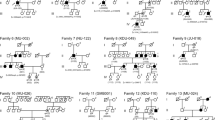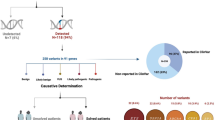Abstract
Purpose
Bardet-Biedl syndrome (BBS) is a rare multisystem ciliopathy. The aim of this study was to describe the clinical and genetic features of a cohort of Chinese patients carrying biallelic BBS gene variants.
Methods
We recruited 34 patients from 31 unrelated pedigrees who carried biallelic pathogenic variants in BBS genes. All patients underwent ophthalmic and systematic evaluations, as well as comprehensive molecular genetic analyses. Ultimately, 14 patients were followed up over time.
Results
We identified 47 diseasing-causing variants in 10 BBS genes; 33 were novel. Diagnosis of BBS and non-syndromic retinitis pigmentosa (RP) were established in 28 patients from 27 pedigrees and 6 patients, respectively. The two most prevalent genes in patients with BBS were BBS2 and BBS4, accounting for 51.8% of the probands. The patients exhibited clinical heterogeneity, from patients with all six primary clinical components to patients suffering from non-syndromic RP. The common components were retinal dystrophy, polydactyly, and obesity, with frequencies of 78.6% to 100%, while renal anomaly frequencies were only 7.1%. Patients exhibited early and severe visual defects and retinal degeneration. Patients with biallelic missense variants in BBS2 suffered fewer clinical symptoms and mild visual impairment. Patients with BBS10 variants tended to have cone dystrophy.
Conclusions
Our study defined the mutated gene profiles and established the configuration of the variation frequencies for each BBS gene in Chinese patients. Overall, our patients showed early and severe visual defects and retinal degeneration. Genetic analysis is therefore crucial for diagnosis, genetic counseling, and future gene therapy in these patients.
This is a preview of subscription content, access via your institution
Access options
Subscribe to this journal
Receive 18 print issues and online access
$259.00 per year
only $14.39 per issue
Buy this article
- Purchase on Springer Link
- Instant access to full article PDF
Prices may be subject to local taxes which are calculated during checkout



Similar content being viewed by others
Data availability
The datasets generated during the current study are available from the corresponding author on reasonable request.
References
Chandra B, Tung ML, Hsu Y, Scheetz T, Sheffield VC. Retinal ciliopathies through the lens of Bardet-Biedl Syndrome: Past, present and future. Prog Retin Eye Res. 2022;89:101035.
Florea L, Caba L, Gorduza EV. Bardet-Biedl Syndrome-Multiple Kaleidoscope Images: Insight into mechanisms of genotype-phenotype correlations. Genes. 2021;12:1–13.
Beales PL, Elcioglu N, Woolf AS, Parker D, Flinter FA. New criteria for improved diagnosis of Bardet-Biedl syndrome: results of a population survey. J Med Genet. 1999;36:437–46.
Riazuddin SA, Iqbal M, Wang Y, Masuda T, Chen Y, Bowne S, et al. A splice-site mutation in a retina-specific exon of BBS8 causes nonsyndromic retinitis pigmentosa. Am J Hum Genet. 2010;86:805–12.
Pretorius PR, Aldahmesh MA, Alkuraya FS, Sheffield VC, Slusarski DC. Functional analysis of BBS3 A89V that results in non-syndromic retinal degeneration. Hum Mol Genet. 2011;20:1625–32.
Shevach E, Ali M, Mizrahi-Meissonnier L, McKibbin M, El-Asrag M, Watson CM, et al. Association between missense mutations in the BBS2 gene and nonsyndromic retinitis pigmentosa. JAMA Ophthalmol. 2015;133:312–8.
Niederlova V, Modrak M, Tsyklauri O, Huranova M, Stepanek O. Meta-analysis of genotype-phenotype associations in Bardet-Biedl syndrome uncovers differences among causative genes. Hum Mutat. 2019;40:2068–87.
Guardiola GA, Ramos F, Izquierdo NJ, Oliver AL. A genotype-phenotype analysis of the Bardet-Biedl Syndrome in Puerto Rico. Clin Ophthalmol. 2021;15:3757–64.
Manara E, Paolacci S, D’Esposito F, Abeshi A, Ziccardi L, Falsini B, et al. Mutation profile of BBS genes in patients with Bardet-Biedl syndrome: an Italian study. Ital J Pediatr. 2019;45:72.
Esposito G, Testa F, Zacchia M, Crispo AA, Di Iorio V, Capolongo G, et al. Genetic characterization of Italian patients with Bardet-Biedl syndrome and correlation to ocular, renal and audio-vestibular phenotype: identification of eleven novel pathogenic sequence variants. BMC Med Genet. 2017;18:10.
Maria M, Lamers IJ, Schmidts M, Ajmal M, Jaffar S, Ullah E, et al. Genetic and clinical characterization of Pakistani families with Bardet-Biedl syndrome extends the genetic and phenotypic spectrum. Sci Rep. 2016;6:34764.
Castro-Sanchez S, Alvarez-Satta M, Corton M, Guillen E, Ayuso C, Valverde D. Exploring genotype-phenotype relationships in Bardet-Biedl syndrome families. J Med Genet. 2015;52:503–13.
Daniels AB, Sandberg MA, Chen J, Weigel-DiFranco C, Fielding Hejtmancic J, Berson EL. Genotype-phenotype correlations in Bardet-Biedl syndrome. Arch Ophthalmol. 2012;130:901–7.
Imhoff O, Marion V, Stoetzel C, Durand M, Holder M, Sigaudy S, et al. Bardet-Biedl syndrome: a study of the renal and cardiovascular phenotypes in a French cohort. Clin J Am Soc Nephrol. 2011;6:22–9.
Li H, Ji CY, Zong XN, Zhang YQ. Body mass index growth curves for Chinese children and adolescents aged 0 to 18 years. Chin J Pediatr. 2009;47:493–8.
Zhou B. Predictive values of body mass index and waist circumference to risk factors of related diseases in Chinese adult population. Zhonghua Liuxingbingxue Zazhi 2002;23:5–10.
Sun T, Xu K, Ren Y, Xie Y, Zhang X, Tian L, et al. Comprehensive molecular screening in Chinese usher syndrome patients. Invest Ophthalmol Vis Sci. 2018;59:1229–37.
Meng X, Long Y, Ren J, Wang G, Yin X, Li S. Ocular characteristics of patients with bardet-biedl syndrome caused by pathogenic BBS gene variation in a Chinese cohort. Front Cell Dev Biol. 2021;9:635216.
Huang L, Sun L, Wang Z, Li S, Chen C, Luo X, et al. Novel compound heterozygous BBS2 and homozygous MKKS variants detected in Chinese families with Bardet-Biedl Syndrome. J Ophthalmol. 2021;2021:6751857.
Tang HY, Xie F, Dai RC, Shi XL. Novel homozygous protein-truncating mutation of BBS9 identified in a Chinese consanguineous family with Bardet-Biedl syndrome. Mol Genet Genom Med. 2021;9:e1731.
Tao T, Wang L, Chong W, Yang L, Li G. Characteristics of genotype and phenotype in Chinese patients with Bardet-Biedl syndrome. Int Ophthalmol. 2020;40:2325–43.
Xing DJ, Zhang HX, Huang N, Wu KC, Huang XF, Huang F, et al. Comprehensive molecular diagnosis of Bardet-Biedl syndrome by high-throughput targeted exome sequencing. PLoS One. 2014;9:e90599.
Guo DF, Beyer AM, Yang B, Nishimura DY, Sheffield VC, Rahmouni K. Inactivation of Bardet-Biedl syndrome genes causes kidney defects. Am J Physiol Ren Physiol. 2011;300:F574–80.
Murphy D, Singh R, Kolandaivelu S, Ramamurthy V, Stoilov P. Alternative splicing shapes the phenotype of a mutation in BBS8 to cause nonsyndromic Retinitis Pigmentosa. Mol Cell Biol. 2015;35:1860–70.
Pretorius PR, Baye LM, Nishimura DY, Searby CC, Bugge K, Yang B, et al. Identification and functional analysis of the vision-specific BBS3 (ARL6) long isoform. PLoS Genet. 2010;6:e1000884.
Denniston AK, Beales PL, Tomlins PJ, Good P, Langford M, Foggensteiner L, et al. Evaluation of visual function and needs in adult patients with bardet-biedl syndrome. Retina 2014;34:2282–9.
Berezovsky A, Rocha DM, Sacai PY, Watanabe SS, Cavascan NN, Salomão SR. Visual acuity and retinal function in patients with Bardet-Biedl syndrome. Clinics 2012;67:145–9.
Grudzinska Pechhacker MK, Jacobson SG, Drack AV, Scipio MD, Strubbe I, Pfeifer W, et al. Comparative natural history of visual function from patients with Biallelic variants in BBS1 and BBS10. Invest Ophthalmol Vis Sci. 2021;62:26.
Acknowledgements
This study was supported by the National Key R&D Program of China (2016YFC0905200). The funding organizations had no role in designing or conducting this research.
Funding
This work was supported by the National Key R&D Program of China, 2016YFC0905200. The funding organization had no role in the design or conduct of this research.
Author information
Authors and Affiliations
Contributions
JZ and YX participated in the study design, acquired the data, and drafted the manuscript. HY, CC, TS, KX, and XZ analyzed the data and aided in interpreting the results. YL designed the current study and revised the manuscript. All authors read and approved the final manuscript.
Corresponding author
Ethics declarations
Competing interests
The authors declare no competing interests.
Additional information
Publisher’s note Springer Nature remains neutral with regard to jurisdictional claims in published maps and institutional affiliations.
Supplementary information
Rights and permissions
Springer Nature or its licensor (e.g. a society or other partner) holds exclusive rights to this article under a publishing agreement with the author(s) or other rightsholder(s); author self-archiving of the accepted manuscript version of this article is solely governed by the terms of such publishing agreement and applicable law.
About this article
Cite this article
Zhong, J., Xie, Y., Ye, H. et al. Phenotypic diversity observed in a Chinese patient cohort with biallelic variants in Bardet-Biedl syndrome genes. Eye 37, 3398–3405 (2023). https://doi.org/10.1038/s41433-023-02516-w
Received:
Revised:
Accepted:
Published:
Issue Date:
DOI: https://doi.org/10.1038/s41433-023-02516-w



